VC Weekly 358

Posted 09 Nov 2015 at 00:09 by Sam C Gittins
Welcome to VC Weekly, N-Europe’s guide to the wonderful world of Nintendo’s download service. Written by Sam C Gittins and Dean Anderson.
A few new games as usual in this edition with everything from Sports to shmup with some slingshots and shoveling of dirt thrown in there as well. What's not so usual though is a bit of a much-needed shake-up in the style of writing, format and indeed the amount of content thanks to the hard work of our very own Dean Anderson - Dcubed on our forums - who has recently become a staff member on N-Europe! He has contributed two of the four reviews in this edition as a guest writer plus he'll hopefully be writing some more for future editions as well; while I have solely written every review for VC Weekly since the Eighth edition - when I took over from Jordan Khoviteri-Zadeh - it would seem that after three hundred and fifty editions this seems like the right time to get a fresh perspective so this feature will play host to guest reviews on a semi-regular basis in addition to my usual ramblings. And with that it's over to Dean...
Greetings fellow readers! So, I'm a pretty ok sort of guy I suppose and I kind of, sort of like games maybe. Been a part of the N-Europe community for over 10 years now and I'm not planning on stopping any time soon! Virtual Console is a game of two halves for me. When I first saw the service get announced in 2005, it came at a time in my life when I had just started looking back towards the past with the aim of catching up with the many games that I missed out on as a kid (can you believe that I had never played Pilotwings SNES before it came out on the VC? It's true!) So the timing was disturbingly perfect!
It also came at a time not long after the re-release of Ocarina of Time on the Gamecube and I was floored at the time at how much better it played than the original PAL N64 cart! High res rendering, a good quality picture and the original 60hz speed!? Was like mana from the heavens for someone who was used to playing N64 games with a crappy RF cable, with massive borders and at a slow speed (like that feeling you got when you saw your favourite movies make the jump from VHS to DVD; the difference was immediately obvious!). So when the VC came around, how excited was I at the prospect of seeing all of my childhood favourites given the spit and polish that these games got on the Gamecube? (hint, the answer is very excited)
So what does any of this mean to you, the reader? Well sir (or madam!) it means that I bring two perspectives to the table here, that of someone who gets to see his childhood favourites brought back, better than ever before with new features (Suspend Saves, I could kiss you! - Well, if you were something actually tangible that is) as well as that of someone who is discovering a classic for the first time. So I write in the hope that many of you can relate to me; and if you don't? Well then, maybe I can help you make some discoveries of your own and create some newly cherished gaming memories that you never knew you even wanted!
Anyway enough from us and on with the games!
Available for download this week we have...
Mario Golf
Pac-Man 2: The New Adventures
Dig Dug II
Pocky & Rocky with Becky

Publisher: Nintendo
Developer: Camelot
Released: 1999
System: N64
That portly plumber sure does get around! Karting, Football, Tennis, you name it and chances are that he’s had an affair with it! None of these other spinoffs are perhaps as storied as his golfing outings however.
While there have been numerous golf titles starring our mustached friend before, during the NES era, the Mario Golf series that we know and love today actually got its start not from them, but rather from a Sony owned franchise called Everybody’s Golf (Or Hot Shots Golf if you prefer your measurements imperial and your words lacking the letter u!)
Camelot Software Planning is a developer with a history that dates back to 1990, but their first foray into the world of golf games was released in 1998. After going through many a struggle with their Shining Force RPG series at SEGA (who were dropping their then current console faster than a flaming potato in favour of the Dreamcast; leaving Camelot high and dry) and various disputes with Sony (the most famous one being the rushed development schedule of their Playstation RPG, Beyond the Beyond), they were given an offer they couldn’t refuse; the keys to the Mushroom Kingdom – where they have continued to make every single Mario Golf and Tennis title ever since.
And it is here that the foundations of the series as we know it were laid. From the core gameplay and physics engine, to the music stylings of Motoi Sakuraba, this game was the real start of the Mario Golf series. So was the 3DS outing your first experience on the links with Mario? The Gamecube or Game Boy renditions perhaps? Well then! What separates the N64 original from its successors, and why is this idiot blabbering on about history that you don’t really care about? Time to shut up and just get on with saying whether or not it’s any good you say? Alright then!
Like most golf games, the traditional “3 click” system is in place here. You press A to start the meter on the bottom of the screen, you press A to set how far you want to hit the ball and then hit A once more when the bar is at the middle of the sweet spot. Simple, effective, classic.
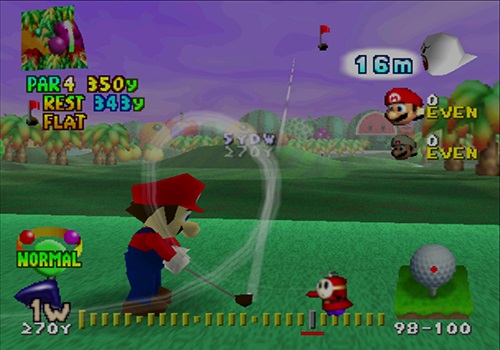
Ahh what a lovely breeze… Hey, where’d my ball roll off to!?
On top of that you have a bevy of other options and controls at your disposal, from the ability to move the camera around the course, to choosing special (and limited use!) power shots, to setting the angle where you want to hit the ball. It’s surprisingly in-depth and yet handled with absolute ease. The controls all translate perfectly fine to the Gamepad/Pro Controller here on the VC and everything handles just as it should do (though some may wish to map X/Y/ZL/ZR to some of the C-buttons if you don’t gel with using the Right stick as the 4 C-buttons for the camera). Series fans may note that the game lacks both the ability to set topspin/backspin, which does mean that you have less fine control over the ball than future games in the series and is something that may take some getting used to if you’re used to the newer games. Likewise, it also lacks the ability to set distance markers on the meter from Toadstool Tour and the detailed simulation line from later games as well. Personally I have never been much of a fan of these additions myself as I feel that they actually offer too much assistance to the player; the lack of a line showing where the ball will roll on the ground actually tasks the player to think more like a golfer and try to predict where the ball is going to roll to, based on the actual lie of the ground and I reckon that many players coming from newer games might actually appreciate the lack of training wheels!
Speaking of which, what may be jarring to some is the surprising lack of Mario-isms. This is in effect the true sequel to Everybody’s Golf and as such it is actually more like a traditional golf game than the newer games in the series. So you won’t be seeing much of the crazy stuff like giant bob-ombs that explode when hit, or Chain Chomps that eat your ball; rather, this is a fantasy golf game with more of a light Mario touch. The courses are mostly realistic in design (and physics too – it has a different feel from later games that will take a bit of getting used to) and all are appropriately in-depth, with an appropriate difficulty curve that works well with each of the different characters and the various modes on offer.
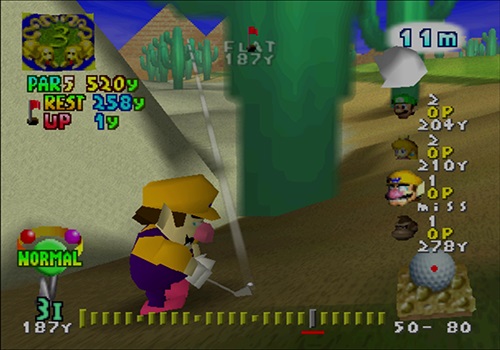
Err… Best of luck with that one Wario!
Also unlike other games in the series is the fact that you start with only 4 characters and the rest must be unlocked (hilariously enough, Mario himself is actually one of the last ones you unlock!). While most are obtained fairly easily through the Get Character match play mode, a few will require you to put the hours in and master the art of Mario Golf to earn a birdie on each of the holes throughout the game (the illustrious Metal Mario is the hardest hitter in the game and is particularly hard won – a birdie on every hole!). Some may bemoan the unlock requirements, but it does add a nice sense of progression to the game and the characters feel suitably rewarding as they all hit harder and further than the last (that being said, some may feel that the character balance is a bit lopsided towards the later ones generally; me personally? Maple, every time!)
With 6 courses (18 holes each) and plenty of modes on offer, including Speed Golf, Tournament Mode, Stroke Play, Ring Shot (scored separately for each character by the way!), Get Character, Practice Mode and the still-exclusive Mini Golf mode that has you putting through 2 courses of 18 holes; there’s plenty of content to keep golf fans coming back for months to come. And on top of all that is the multiplayer, which includes Match Play, Stroke Play, Mini Golf, Speed Golf and the hair wrenching Club Slots, which pits you and your friends against an evil slot machine that limits your club selection to whatever you draw from it.

Heaven help you if you end up playing without a wedge like poor Luigi here!
This was one of the better looking games of the N64 era and it still has a certain charm about it today. Mario and friends may not have fingers, and they may look like they’re made out of lego pieces, but there’s a sort of hilarious charm to the primitive way they move and look that I personally like myself. Audio wise, the stylings of Motoi Sakuraba haven’t changed much over the years and fans of Camelot’s other games will be right at home here.

See? Bowser doesn’t need opposable thumbs to play mini golf, so you don’t either.
Overall it’s still the same great game it was back in the N64 days. Some players who have only ever played the newer games will probably find the lack of Mario-isms to be quite jarring, but that also makes it still quite unique amongst the rest of the games in the series. Fans who have played this game before will be glad to know that this is the US version of the game, running at the full, blistering 60hz that it should do, so make that upgrade without hesitation! (those with a keen eye will also notice that the intro music in the US version is actually different from that PAL version. The wind measurements are also different too; keep an eye out for it and you’ll notice it!) It should be noted that there is no support for the Transfer Pak capabilities from the N64 cartridge version though, so those hoping to move their characters over from the 3DS VC version of Mario Golf for the GBC are out of luck sadly. Thankfully no actual game content is rendered inaccessible as a result.
Verdict: A Golfing Golden Oldie that still lands a Hole in One!

Publisher: Bandai Namco
Developer: Namco
Released: 1994
System: SNES
Wandering far from his maze-munching roots, the yellow fellow takes a trip into Pac-City in Pac-Man 2: The New Adventures which ends up being something surprisingly unexpected yet entertaining in its own way. Following a brief introduction where Pac-Man introduces himself along with the simple point-and-click mechanics of the game, it transpires that our hero has a family consisting of himself, Ms. Pac-Man, Pac-Jr and Pac-Baby; It's all a bit surreal really but it gives an excuse for some wacky adventures which typically revolve around collecting various items in order to keep your family happy, though eventually after running into your old ghost foes - Inky, Blinky, Pinky & Clyde - you find out that they are stealing ABC chewing gum from children and are taking it to the Ghost Witch, but what purpose does this serve? What does it all mean? You'll have to tune in to - or rather play - the New Adventures of Pac-Man to find out!
That's essentially how it is because each section of the game plays out like an episode from the Saturday morning kids TV show, once you have your objective such as getting some milk for Pac-Baby or a flower as a birthday gift you set off not by normal means of movement as in the previous game but instead by influencing events on-screen by shooting from a slingshot in a similar vein to point and click mechanics, it sounds really odd trying to describe it but the indirect control method works rather well. There's a whole host of crazy characters to interact with as well during the course of your adventure, it's all reasonably amusing in places too with some nice touches spread throughout, seeing our hero hang-gliding is a particular highlight as is consuming a Power Pellet to become Super Pac-Man which of course is the only way he can chase down those pesky ghosts.
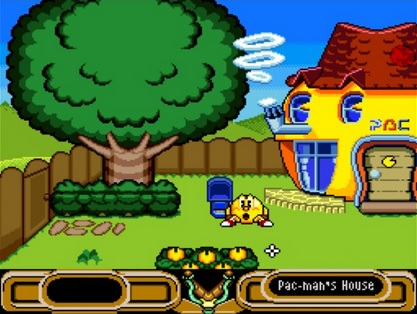
Pac-Man, on the Pac-Grass, outside his Pac-House, sat on his Pac-a.. you get the idea.
You really are responsible for Pac-Man's wellbeing so interacting with everything at the right moment is key to your success, further to this he also has a range of emotions which will change how certain situations are handled; for instance when happy you can clear a chasm with ease though if the poor fellow is depressed then he'll need some encouragement, plus if he's angry then he will get into fights with little regard for his own safety. Though it seems like quite an odd mechanic you soon get used to it as it becomes yet another quirk to a title which is already so off-the-wall for the franchise and yet makes so much sense in context, of course how much people take to this title will likely vary but personally it's something which is easy to warm to.
Some sumptuous SNES visuals are present here with a really decent amount of depth perception making the environments seem suitably substantial, while there may only be a limited amount of areas there's a great deal of variation between them which makes it seem worthwhile; animation levels are brilliant featuring some particularly great examples such as Pac-Man's ever-changing expressions, I don't have the Mega Drive version to compare with but the colour palette just looks more at home here. Apparently there are differences in sound as well, fortunately this version seems to be the one which has hilarious voice samples for our hero which can only be a good thing, the accompanying music is decent enough too which isn't bad considering Pac-Man never really had a defined form of background music from its arcade roots aside from the introduction and the between-level scenes so it's impressive just on that level alone, let alone all of the fantastic effects this title has too.

Insert obligatory Mine Cart stage reference here.
Of course no game in the franchise released since the original would be complete without having - you guessed it - the original arcade game playable in it, indeed within the very virtual arcade, within the virtual game AND on the Virtual Console no less... it's almost like a "Pacadox" if you will. Ahem, in any case you can play the first game in all of its original pixel perfect, pill-popping glory - well it was the Eighties - but wait as that is not all, for if you can find the three cartridge pieces in the game then you will also unlock Ms. Pac-Man as well which is excellent value for money; the first game is also based on the NES release but with 16-Bit graphics. Interestingly in the Megadrive version an exclusive game called Pac-Jr. is unlocked instead, Pac-Jr. is a graphic and level hack of Ms. Pac-Man, and not a conversion of the unauthorized arcade game Jr. Pac-Man. This was done because a Genesis version of Ms. Pac-Man was already released prior to this game and Namco did not own the rights to Jr. Pac-Man at the time. Regardless of which game you're playing though they all look fantastic either on the big screen or on the gamepad.
Easier to recommend than I thought it would be, this is a Pac-Man title with a distinctly different style to anything which has come before it yet is also an experience which is the embodiment of creative brilliance which the original game was known for; yet this takes a new concept for the series and manages to execute it very well indeed. Just don't go into this expecting something similar to the arcade game and you'll be fine, especially if you're already a fan of Namco's most famous mascot as there's just so much to love here plus it's an enjoyable adventure to boot. Purchase this as a curiosity, you really can't go wrong with it for the price and who knows, you might just develop a soft spot for it.
Verdict : Pac-Man proudly partakes in an excellent expression-fuelled adventure like no other.

Publisher: Bandai Namco
Developer: Namco
Released: 1989
System: NES
With the original Dig Dug being reasonably popular, it's easy to see why a sequel would be made but alas it was not to become as widely known for it only ever got released in the arcades along with a NES port, neither of these would have been widely available or even properly released in Europe so I wouldn't be too surprised if anyone had heard of it; indeed I would be more surprised if anyone had as it turned out to be news to me at least. In quite the departure from the first title you're no longer underground but instead on the surface of an island instead where the level takes place, you won't be digging very deep though as the objective is to defeat the various enemies who are wandering around the area so you can beat them by destroying certain sections of the island and watching them plummet into the ocean or simply by inflating them until they explode.
This brings in an extra element of being more tactical which the original had but in a different way, there are a fair few cracks which run through the ground so you've got to plan ahead as while you will detach that part from the rest of the island, if you're on it when the section falls then you'll drown as well. Obviously the safer option is to just merely pop all of the enemies but of course this won't get you the higher scores so the game encourages you to be a bit risky, even to the point of awarding extra points for successive sinking so synchronisation is key here; also the further you get then the trickier the enemies become as you start out against the mostly harmless Pookas but once the fire-breathing Fygars are thrown into the mix, things tend to heat up a bit.
I suppose the largest problem with this title would be the amount of repetition within the gameplay which also plagued the original to an extent, you do at least get a whole seventy-two stages before you see anything being repeated but by that time you may well have tired of the game entirely. For this reason I would advise playing this in short bursts, use the Save Suspend feature when you've had enough and if things get too difficult then you can always take advantage of the Restore Points if you really want to; this is probably one of those experiences which is better-suited to the gamepad but it's always good to have these options available.
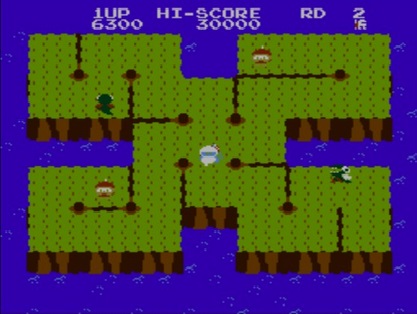
Can you dig it? Yes, but I'd rather not.
Clearly the visuals were never going to be a huge advancement over the original, with a colour palette featuring mostly just a handful of instantly recognisable colours things do inevitably get rather samey with a simple colour change only taking place once in a while; the animations are still charming though. The audio isn't bad as it at the very least features a selection of simplistic songs as opposed to just a single one for the entire game! It will still get on your nerves after just a short amount of time though even with the quirks sound effects breaking things up a bit.
It's certainly a different experience from the first outing which warrants playing if the high-score chasing nature is enough to entice you, if it's not then I'd probably advise giving it a miss and naturally if you haven't played the original Dig Dug in all of the years since its original release then you really need to play that first if you feel so inclined to do so. You could do a lot worse than this for the price though, it's at least a lot better than many shovelware titles released on the eShop for a similar price but just be aware that it's still a rather limited albeit charming experience.
Verdict : Don't dig too deep for this one as just a shovel of its digital dirt is enough.

Publisher: Natsume
Developer: Altron
Released: 2002
System: GBA
The Pocky & Rocky series is one with a history as odd as the games themselves. Known in Japan as KiKi KaiKai, it started off in the arcades in 1986 as a free roaming top down shooter in the vein of contemporary classics of the day, such as Capcom’s Gun.Smoke and Commando. Originally developed by Taito, it eschewed those more western friendly themes in favour of a cutesy wootsy take on traditional Japanese mythology and never officially left Japan. Some may know its bootleg counterpart, known as Knight Boy, however; a pretty odd choice of name really, considering that the playable character is clearly a girl!Fast forward a few years, whizzing past another Taito developed entry in the series that remained an exclusive to the Famicom Disc System in Japan (oddly enough, a remake of sorts that told the same story but now with Metroid inspired gameplay!) and we come to the games that most people who know the name Pocky & Rocky will identify with. Pocky & Rocky 1 and 2 were both developed for the SNES, not by Taito this time but by Natsume instead!
Those games expanded greatly on the original gameplay as seen in the first arcade title, adding in lots of new moves, vastly improved visuals, far more intricate level and boss designs, wonderfully fitting traditional Japanese styled music and awesome co-op gameplay! The stages were far longer, with a big focus on unique set pieces and gameplay gimmicks that constantly spiced things up (especially in the second game, which also introduced some minor RPG-like elements, such as currency that could be used to purchase upgrades and all sorts of power ups and goodies that would rain death and destruction upon the adorable demons and ghosts that stood before you and your buddy).
So a game that originally started as a simple one off in Japanese arcades ended up becoming an international series, thanks to an outside developer who took a liking to the original game; phew! Sadly, despite critical acclaim and relative popularity back in the day, the Pocky & Rocky series never made the jump to next gen consoles and would remain but a happy memory for many a fan of classic 2D top down shooters… Until all of a sudden, a little known developer called Altron revived the series once more on the GBA that is!
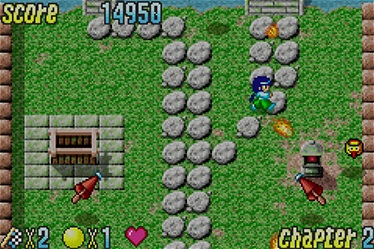
Making Japanese demons cute and cuddly way before Yokai-Watch cribbed its style.
Unlike the SNES games however, this game mostly takes after the original arcade game. That means that the stages are very short (around 2-5 minutes at most) and are all very simple in design, with your path being very linear and the only barrier to your progress being the need to find a key in each stage to unlock the door to each stage’s boss (and they’re all mostly in plain sight). Likewise, there is no co-op gameplay of any kind; in fact, there are no extra modes whatsoever outside of the main game (there’s an unlockable hard mode, but it isn’t particularly interesting in its design. Don’t expect any extra enemies, level design alterations or extra boss attack patterns of any sort; you’re getting some extra enemies thrown at you that take a few extra hits to kill and that’s it buddy!)
With there being only a scant 7 stages on offer, the game doesn’t last very long. It isn’t particularly hard either and infinite continues are the order of the day here, so unless you’re into high score chasing; this will be a brief experience for you. A good fit for handheld play, where play sessions are short perhaps, but on a console? Chances are that most will be left dissatisfied with the length.
Luckily the game at least controls well enough. As this game errs closer to the arcade original, the controls and gameplay mechanics are all very simple. You move, you shoot with the A button, you have a close range (and perhaps overpowered) fan attack with B and a screen clearing bomb with L or R; that’s it. Fans of the SNES games will probably be left pining for the more complex moveset available in those games, but what’s here controls tightly and works well enough for the simple gameplay on offer. You also have a choice of three characters (go on, have a guess which ones!); however, there is very little to distinguish them from each other. While each have their own special move, it is only activated when the player grabs a rare powerup icon; and even then it makes little difference to the gameplay as they all feel very similar.
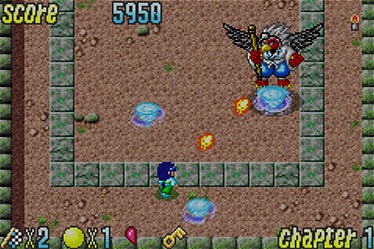
Even this boss agrees that the controls are simple, that’s why he’s about to die.
Aside from each character’s special move, you also have a power up that lets you shoot a more powerful version of your standard attack and… that’s about it. There really isn’t much else to the gameplay and it all feels a bit half baked. Even given the fact that it was designed to be played on the go in short bursts, there just isn’t much depth to the gameplay at all; in fact, more often than not, the best strategy to get through the game is to just ignore most of the enemies and just rush through as fast as you can (and as they don’t put up much of a fight outside of the bosses, you’ll probably just want to ignore most of them anyway!)
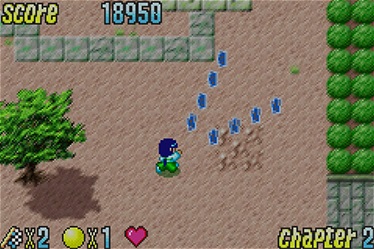
Sure you can shoot in two slightly different directions now, but you still ran right past everything anyway.
Like with the rest of the game, the visuals are also very simple. Lacking the detail and care of the SNES games, the visuals are fairly sterile and don’t offer much variety throughout. They are bright, clear and functional; a good fit for the dark screen of the original GBA but on a console? You’re gonna most likely be left feeling cold. The sound is also nothing particularly noteworthy, pretty much the Japanese folk equivalent of elevator music. The dialogue is mostly Engrish however and will likely deliver a good chuckle or two at least!

There must be some good reason why you’re standing in the middle of an empty room with nothing in it while holding a bowl of water, but I’m obviously too dumb to figure out why.
The Virtual Console’s Suspend Save feature comes in handy as a lazy man’s way of saving progress, though password saves are of course, still in place for those who want to skip ahead. Given how short the game is though, chances are that you probably won’t make much use of it however.
In general it’s definitely a product of its time. In an era where publishers were suddenly reviving their SNES era classics, Pocky & Rocky with Becky is not bad as a little time killer while on the bus, but when removed from its context it fails to stand up as an experience worthy of the Pocky & Rocky title; lacking the gameplay depth and the attention to detail that made its predecessors true classics. It’s not a bad game, but there isn’t much on offer here unless you’re a diehard fan who is curious about seeing another game from the series that never originally came out in Europe.
Verdict: A shamelessly simple game that promises little and does a good job doing just that.
That's it for another installment of VC Weekly which will return again soon. So until then, enjoy the rest of the week and Game On!






















